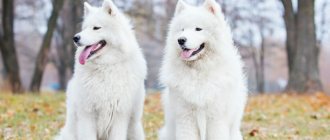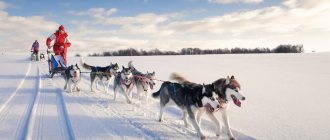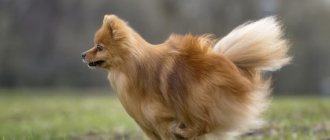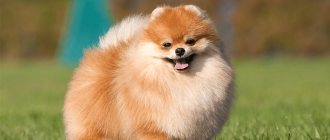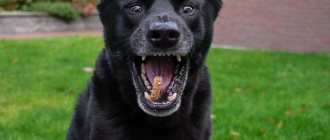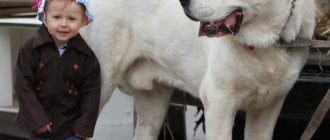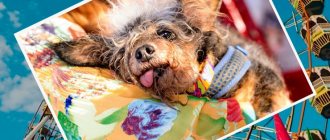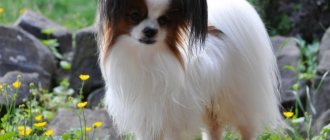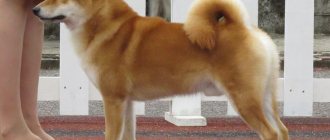The top most powerful dogs in the world include breeds with different personalities. Moreover, some of them, in addition to strength, have a good disposition and amenability to training, while other dogs, on the contrary, have innate distrust and are relentless in the face of danger.
Which dogs are among the TOP most powerful dogs in the world?
The assumption that among the dangerous breeds of this world there are breeds with hereditary cruelty, usually including dogs such as the pit bull, is nothing more than the opinion of people who are poorly informed on this topic.
Breeders have indeed provided dogs of fighting breeds with hereditary characteristics, due to which strength properties are maximally developed.
It is this fact that subsequently contributes to success in competitions and instant recovery of their body. But this does not mean that this breed of dog is difficult to train or rushes at everything moving like a piece of meat.
~ Staffordshire Terrier ~
Perhaps the Staffordshire Terrier deserves to be the top most powerful dog in our vast world.
The breed is characterized by unsurpassed courage.
The ancestors of these strongest dogs were bred in America; for this purpose, the most dangerous and powerful dog breeds were used for baiting, brought from Scottish, English, Irish and Spanish countries. By the way, these animals, compared to other service dogs, do not have innate distrust. Such a dog always strives to please its owner and provide protection to loved ones.
The breed is distinguished by its peculiar wide chest, you can simply feel the explosive power in it. Initially, the Staffordshire Terrier was bred as a grass dog for hunting, after which it began to be used in fighting competitions.
2.Newfoundland
A popular breed among dog breeders, it was bred on the island of the same name. Only to this day dog experts argue about the time period of origin of these handsome athletes. If St. Bernards are rescued on land, then Newfoundlands are rescued on water. Therefore, dogs can swim and dive excellently - they even have membranes between their toes. The breed has a poorly developed hunting instinct and absolutely no aggression. So the dogs, although strong, are good-natured. They have high intellectual capabilities and can make independent decisions in emergency situations. In addition to rescue, such strongmen are involved in the transport of heavy loads. The weight of an adult Newfoundland is around 80 kg.
~Pitbull~
Next, the top of the strongest dogs continues with the interesting breed Pitbull. These animals are friendly and prefer to always be in the company of humans.
Nature has endowed the breed of strong dogs with an unusual skeletal structure and amazing muscles. It is these two factors that allow trained pit bulls to bear different weights. Initially, the animals were used to bait large and dangerous animals, then they were used by butchers to protect trade stalls with meat - while the stall was protected not from people, but from the invasion of other dogs.
Mastiff
These gentle giants have come a long way from their warlike ancestors. Mastiffs have come a long way to develop into the loving dogs they are today.
- Pros: The Mastiff is a great dog for families with children and other pets. They also make excellent guard dogs. They are attached to family and friends, and mastiffs do not like strangers or animals. Dogs of this breed have short hair and shed little. They are not as energetic, so they need less exercise.
- Cons: Dogs of this breed tolerate cold weather well, but are not adapted to heat. Mastiffs have low intelligence and are a bit stubborn. They need an experienced trainer. They are known to drool profusely.
~ Tosa Inu ~
Eighth place in the TOP 10 is occupied by the strongest and most dangerous Tosa Inu - dogs bred in Japan. According to experts, this breed is a real samurai, so it is not suitable to keep such an animal as decoration.
Today there are few true Tosa Inu left. Real representatives of the breed live and protect rich estates in Japan. Dogs living in Europe are also beautiful and noble, but already have slight differences in character and appearance.
Record holders from all over the world
The strength and power of some four-legged animals turned out to be so amazing that they decided to record them in the Guinness Book of Records. Among the most unusual record holders are 4 dogs:
- St. Bernard Raittes Brandy Bear from the American state of Washington. This dog has held the championship since 1978. At the weightpulling competition, Raittes pulled 2905 kg of railway rails over a distance of over 5 meters. For this he was awarded the title of the strongest dog in the world.
- Pitbull Tyson from Donetsk. Like Raittes, Tyson competed in pulling weights. Despite the fact that he dragged only 385 kg over 4.8 meters, he was recognized as the strongest dog in Europe. The thing is that Tyson came to the competition without preparation. Due to lack of regular training, the real abilities of this dog are still unknown.
- Rottweiler Bewdel from England. Despite its female gender, this dog weighs 95.5 kg, while ordinary male Rottweilers weigh no more than 60 kg. Such an impressive weight is explained by overfeeding, so Byudel is not only the largest, but also the fattest Rottweiler.
- Whippet Wendy from Canada. This pet, which received the title of the most muscular, stands out from the rest of the four because of its breed. Due to an accidental genetic glitch, even Arnold Schwarzenegger could envy this hound’s appearance.
With regular training and good physical data, even an ordinary mongrel can become a record holder. For this reason, strength and endurance should not be dulled by a sofa lifestyle. Instead, both qualities are recommended to be used for their intended purpose in different areas of activity.
~ Alabai or Central Asian Shepherd ~
In the ranking in seventh place in the “Top of the strongest dog breeds” is one of the ancient breeds - Alabai.
Initially, the Central Asian Shepherd was bred to protect livestock and trade caravans from attacks by wild and dangerous animals. Sometimes the breed was used to move weights, and was also used in battles in the CIS.
Characterized by fearlessness and endurance, has the ability to properly use their strength.
Rating of the most dangerous dog breeds in the world
Strong dogs have different temperaments and levels of aggression. Some powerful dogs are good-natured giants that can be safely left with children. Others are muscular animals that can show unmotivated aggression and are difficult to train. The latter are often included in ratings of the most dangerous breeds. Some countries prohibit their keeping, breeding or import.
American Bandog
Bandogs (“chain dogs”) grow at the withers to at least 50 cm, and their weight can reach 80 kg. The selection was carried out in the direction of perseverance and fearlessness. The dog's huge size and lack of fear often leads to aggressive behavior. Representatives of the breed require a firm hand and a professional dog handler.
Bull Terrier
Funny dogs with ambiguous appearance (height 35-47 cm, weight 32-50 kg ) are real aristocrats. They perfectly combine friendliness and aggression. A properly raised animal will show its qualities as a fighter only when circumstances require it.
Rhodesian Ridgeback
Tall ( up to 75 cm at the withers, weight about 40 kg ) red dogs from South Africa were bred for guarding and hunting. A group of dogs can stop and hold the lion until the hunter arrives. Without regular physical activity, the Ridgeback becomes dangerous to others.
Gul-dong
Representatives of the Pakistani breed ( height up to 50 cm, weight usually does not exceed 55 kg ) were bred to participate in dog fighting. High level of aggression, which cannot be suppressed even through training.
Brazilian Fila
The height of a male of this breed can reach 80 cm . The breed was bred to guard the farm and drag heavy loads. Dogs are almost always aggressive towards their relatives, but such behavior is not grounds for disqualification at the exhibition. Its impressive size, coupled with this behavior, makes the Fila a dangerous breed.
Bullmastiff
They have impressive sizes ( height about 75 cm, weight up to 80 kg ). Bullmastiffs are not prone to aggressive behavior, but cases of attacks on humans have been recorded more than once. It's all due to the lack of proper education.
Doberman
Tall, stately dogs ( height 64-75, weight 35-47 kg ) were bred for police service. They received the status of a dangerous animal because of their formidable appearance and devotion to their owner. A well-mannered animal gets along well with children and does not cause disturbance to humans.
American Bulldog
A medium-sized dog ( height about 55 cm, weight up to 45 kg ) is considered one of the most dangerous. A muscular body, speed of movement and innate qualities of a fighter allow the dog to win most dog fights. An untrained animal can also show aggression towards humans.
Basenji
This small dog ( height 40-43 cm, weight no more than 15 kg ) can be dangerous to humans. The ancient breed is difficult to train. Lack of proper education can lead to aggressive behavior.
Wolfdog
Despite its attractive appearance ( height is about 45-78 cm, weight up to 65 kg ), such a hybrid is dangerous. The instincts of a wild animal (wolf) always prevail. They are difficult to train and are prone to spontaneous outbursts of aggression. Not a single such hybrid is recognized by the FCI; breeding is prohibited in most countries.
~ Doberman ~
According to the common people, Dobermans are evil and very dangerous, they are the ones who are capable of killing even their owner, but this is all speculation.
In fact, the animals are friendly; with their help, many have managed to cure nervous and mental disorders. But in searching and protecting loved ones, Dobermans have no equal; at this moment they really turn into a death machine.
Rottweiler
These are calm, brave and heavy dogs. They can weigh up to 60 kg.
- Pros: Intelligent and attentive, Rottweilers make excellent working dogs. They are surprisingly friendly and sociable. Despite their reputation, when trained correctly they are gentle and family friendly.
- Cons - Training should begin as soon as possible, while they are still small enough to be easy to handle. Rottweilers generally do not like other animals. They do not like to be alone and become destructive and aggressive if they are bored.
~Perro de Presa Canario~
In fourth place in the ranking of the most powerful and dangerous dogs is the Perro de Presa Canario breed. Initially, the breed was used for hunting large animals and for slaughtering livestock - the dog strangled animals by the throat with its huge jaws.
In the Canaries there was a law prohibiting ordinary people from keeping such a breed; such a right was granted only to hunters and butchers.
Saint Bernard
Our list of strongmen opens with the strongest dog, and it was bred in the 17th century by the monks of the monastery of St. Bernard to save people. overcoming mountain passes and saving people in ice, year after year this breed only improved its abilities.
Loyal, very obedient St. Bernards sincerely love people, and communicate very carefully and tenderly with children. A very large dog, reaching up to 80 cm at the withers, has massive paws, and the color is usually red with white spots, or vice versa.
The image of these human favorites is widely represented in various fields of art, from painting to feature films.
2
~Bull Terrier~
The genes of the Dalmatian, English Bulldog and English White Terrier are mixed in the Bull Terrier's blood.
The most interesting fact: keeping such a breed was previously considered good manners among the inhabitants of Oxford University. As you can judge from the photo, the animal’s head consists of forty percent jaws, which it can wield perfectly.
How to choose the right strong dog?
In general, there are no specific features for choosing the strongest animal. You just need to understand which breed suits you best than others, everything else is small nuances.
In addition to the breed, several factors need to be taken into account:
- Dimensions of the animal. If you need a dog for protection and security, then it is better to choose a pet whose height is 60 cm and above. Of course, to protect a house or people, it is good not only for the dog to be strong, but also massive.
- The weight of the animal should also be taken into account. The best option is if the pet weighs about 50 kg. In general, weight is not particularly important, but a massive and strong pet will always be able to knock down an attacker.
- Temperament. As you can understand from the description of the species, it is important to take into account the character that the dog will have. For example, a Doberman is suitable if you want to get a well-mannered dog without putting too much effort into training it. Sweeter-looking dogs, such as huskies, will require more time and effort to train.
~Kangal~
The breed is a bit reminiscent of the Central Asian Shepherd, but the Kangal, as illegal fights have proven, is stronger and more resilient.
The size of the animal is terrifying, which makes it an excellent watchman and security guard.
Tags
Alabai Bull Terrier Doberman Kangal Perro de Presa Canario Pitbull Rottweiler The most powerful and dangerous dogs in the world Central Asian Shepherd Staffordshire Terrier Tosa Inu Fila Brasileiro
Very interesting, and most importantly useful!
Many people, when getting dogs, want, first of all, to feel protected. Large breeds of dogs are best suited for this, capable of instilling fear in others just by their appearance. Having such a friend at home needs to take into account not only the pros, but also the cons, especially for families with children. Large, strong dogs require certain conditions and training. Let's figure out which dog breeds are the strongest in the world, and what their positive and negative sides are.
Page content
20 American Bandog
The Bandog is a family-friendly breed because it loves children and is instinctively protective of them, but can also be a service dog. But he is not an aggressor. But if someone else is playing with the child, the games should not be too active, otherwise the bandog could assess such a situation as a danger. He doesn't get along well with other pets and this also applies to other dogs. The puppy needs to get used to their presence in order to avoid conflicts in the future. He is very distrustful of strangers and wary of them. He is a great guardian of people and property. Proper upbringing and training are very important for this breed and should not be underestimated. If you raise a Bandog correctly, he will be a good friend with whom you will not have to be afraid of anyone, because he will be able to protect you. In addition, he will listen to his master without any problems if he has mastered the training. It may take him a while to learn the commands, but then he won't forget them.
Flaws:
- needs an experienced owner;
- constant need for physical and mental development;
- aggression;
- sensitive to cold.
Advantages:
- has protective qualities;
- hardy;
- smart;
- has good health.
19 Bernese Mountain Dog
The Bernese Mountain Dog has a moderate disposition, is balanced, cheerful and sociable. At a young age he is spontaneous, over time his behavior becomes more stable. He is very attached to his owner and needs close contact, so you should not leave him alone for a long time. The Bernese Mountain Dog is also not suitable for being kept in a pen - it must be able to move freely around its territory and have unrestricted access to the house. This breed tends to be submissive, with females more focused on cooperating with the handler and males more self-confident, which can make them less disciplined.
As a vigilant and observant dog, the Bernese Mountain Dog is a good, quiet watchdog. It is true that it does not guard territory with the same dedication as the Caucasian Shepherd, but it is effective in scaring off intruders. People he knows are usually greeted warmly, he may stay away from strangers but will accept them if their hosts greet them.
Bernese Mountain Dogs Patient and understanding dogs of this breed get along well with children of any age. But leaving them alone or entrusting a child to take the dog for a walk is not worth it due to the impressive size of the pet. The Bernese Mountain Dog usually gets along well with dogs and other pets, although there are exceptions - the source of inappropriate behavior is usually errors in upbringing or an abnormal psyche. The Bernese Mountain Dog is active and energetic. He requires a lot of exercise, but he is not competitive, so hiking would be better than running a bike. An adult dog needs to be walked several hours a day. A bored and uncontrollable Bernese Mountain Dog may destroy objects in the house or dig holes in the garden. Unfortunately, most Bernese dogs are litter pickers. They will also sometimes chase a cat or other animal while walking.
Flaws:
- quite expensive to maintain;
- tends to collect waste;
- does not live long.
Advantages:
- excellent family dog;
- friendly to people;
- loves children;
- a good watchman and security guard;
- smart, easy to train;
- suitable for sports;
- We are tolerant of other animals.
18 German boxer
The Boxer is a brave, confident dog with boundless energy that needs to be controlled. if not raised properly, it may try to dominate the owner. Therefore, consistent training needs to start very early. Boxers are wonderful family dogs and children's guardians. They are full of joy, always ready to play. They can conflict with animals, especially with other dogs, so it is better to avoid ambiguous situations.
Flaws:
- does not tolerate other dogs well;
- requires a lot of exercise;
- some may drool.
Advantages:
- excellent defender;
- calm and balanced;
- child friendly;
- attached to family;
- smart;
- easy to care for.
17 Bulldog (pit bull, American, English, etc.)
The Bulldog is an intelligent, cheerful and sociable dog. Compared to the human character type, he is straightforward and sincere. He doesn't like his family, especially his children. It tolerates other animals well and will live in harmony under the same roof with either a cat, a rabbit or a guinea pig. Doesn't require long walks, let alone running. For these reasons, it is an ideal breed for living in urban environments. Raising a bulldog is not difficult if the owner is consistent. He senses any weakness in the owner's character and uses it to his advantage. Dogs of this breed are extremely attached to their owners and love them immensely. There is absolutely no aggression in them, and they can follow their owner step by step.
Flaws:
- feels unwell under the influence of high temperatures;
- independent and stubborn
Advantages:
- attached and devoted to family;
- shows tolerance towards children;
- loyal to other animals in the house;
- does not require intensive spending time
16 Caucasian Shepherd
They have a strong instinct of ownership, and any intruder who appears on their territory will be attacked and driven out.
In a foreign place they are calm and reserved, but never timid. Excessive aggression is not courage at all, but rather a lack of self-confidence. Caucasians are noisy dogs. They are very vigilant and react to the slightest noise. Calm, it is difficult to unbalance them. At the same time, they are very proud dogs; they have a strong, independent character with a great sense of self-esteem. For centuries they worked independently, protecting herds of domestic animals from wolves and bears. Such work has shaped their personality, and they cannot be expected to completely submit to human will. You need to make friends with such a dog and treat it as a partner, only then will it allow the owner to take a leading position in the herd.
Flaws:
- prone to aggression;
- independent and stubborn;
- Experienced owner required.
Advantages:
- properly brought up, he is extremely devoted to his family;
- an impeccable, incorruptible watchman;
- healthy and resilient;
- economical to maintain (for such a large dog).
15 Doberman
The Doberman is a dog with a decidedly strong character, extremely domineering, which will always try to subdue its owner. From the moment a dog appears in the house, the guardian must seriously engage in its upbringing. It takes a lot of patience, persistence and love to raise him correctly. He does not tolerate harsh behavior, and it will not be possible to force such a dog to do anything. The Doberman is very observant, will notice every weakness of the owner and will try to extract privileges from it for himself. The Doberman is very affectionate and devoted to his family. But you shouldn’t expect complete obedience and obedience from him.
Flaws:
- an experienced owner is needed;
- requires consistent control;
- tends to dominate.
Advantages:
- guard dog;
- vigilant guardian;
- very attached to his owners;
- brave and faithful;
- hassle-free care
14 Estrela Shepherd Dog
This is a very hard working dog, extremely brave and incorruptible, making it an excellent guard dog. She is extremely vigilant and does not tolerate strangers on her territory. The dog looks like he is lazily resting, but this is only an appearance. This shepherd attacks unexpectedly, quietly, without warning. This is a very willful dog, but training is necessary to establish the necessary relationship between the dog and its owner. Training should begin early, from the first weeks of a dog’s life, clearly establish a hierarchy and teach it the rules of obedience. This dog is too aggressive, his excitement can lead to a situation in which no one can control him.
Flaws:
- very independent;
- aggressive;
- tends to dominate;
- requires early training;
- not suitable for city life
Advantages:
- reliable defender and guard;
- very strongly attached to the owner
13 German Shepherd
The German Shepherd is one of the few breeds that can perform a wide range of tasks and be used for many purposes. This dog has an excellent temperament, she is balanced, confident, but at the same time gentle, except when someone provokes her. This dog is faithful and devoted not only to the owner, but also to all other family members. An excellent playmate, good contact with children. The German Shepherd needs constant contact with people, is not used to loneliness and does not tolerate it well.
Flaws:
- this dog is quite noisy;
- shed profusely;
- boys may demonstrate superiority over relatives of the same sex
Advantages:
- learn quickly;
- become attached to the family;
- good watchmen and protectors;
- Suitable for dog sports;
- subordinate to the owner;
- communicates well with children;
- can live with other pets
12 Great Dane
The Great Dane is the most peaceful of all Molossians. It combines impressive size and elegance with great affection and courage. He is self-confident, balanced, and has an average temperament. It's quite difficult to keep him off balance, but when he's angry he can be a formidable opponent. Distrustful of strangers, the Great Dane is ideal as a guardian and protector and only intervenes when absolutely necessary. The Great Dane is strongly associated with its owner, so it should not be isolated. This sensitive giant does not tolerate loneliness very well. This can cause irreversible changes in his psyche.
Flaws:
- expensive to maintain;
- not very resistant to weather conditions;
- drools quite profusely;
- doesn't live long
Advantages:
- strongly attached to caregiver;
- smart and trainable;
- children's ideal friend;
- feels good in the apartment;
- tolerance towards dogs and other animals;
- good guardian and protector
11 Great Pyrenees
The Pyrenean Mountain Dog, known as the Great Pyrenees dog, was bred to guard sheep. His loud bark scares away bears and wolves. He is a wonderful family and guard dog, very emotionally attached to his owner. He has a very independent character and therefore requires early socialization and therefore very consistent training. He needs a lot of exercise and it is advisable to have a large fenced area where he can move freely. This affectionate, balanced, calm dog is very devoted to his family. He cares not only about family members, but also about other animals living in the same territory with him.
Flaws:
- independent character;
- likes to dominate;
- stubborn;
- requires expensive, long-term maintenance
Advantages:
- excellent protector and guardian;
- attached to the owners;
- barks a little;
- takes care of children
10 Irish Wolfhound
The Wolfhound is a calm, gentle and patient dog - with due care due to its weight and size, it will make an excellent companion at home with children or other animals (provided they are not overly dominant in nature). These dogs are unconditionally devoted and loyal to their family. Contact with other members of the household is very important for them, so closing the playpen is out of the question. Wolfhounds are also intelligent and very interested in the approval of their owners, which makes them smart students.
Flaws:
- expensive to care for;
- does not live long;
- excessive shyness or hyperactivity
Advantages:
- attached to family;
- friendly and non-aggressive;
- loves children;
- easy to learn;
- smart;
- gets along with other animals
9 Leonberger
Leonberger's character is generally quite gentle and calm. A true lover of home and herd, which he creates together with other animals, and most importantly with his loved one. He will show truly angelic patience and understanding towards children. But when playing with him, you need to be careful, given the huge size of the dog. Therefore, it should always be led by adult family members. He is not the kind of dog that will wait for every alarming movement in the immediate vicinity of his territory and raise the alarm at a sound that for some reason he does not like. However, it cannot be said that for this reason he is a poor watchdog - if a threat arises, the Leonberger's innate vigilance and attention will certainly be put to good use and the dog will immediately intervene.
Flaws:
- caring for it is expensive;
- sheds heavily;
- brings a lot of dirt into the house
Advantages:
- devoted to his family;
- smart;
- treats people well;
- easy to learn;
- gets along with other pets;
- good watchman
8 Mastiff
The English Mastiff is gentle, phlegmatic and tolerant towards all family members. He becomes very attached to her. It shows itself perfectly as a guard dog - it is always alert, but behaves silently. He is large, massive, muscular. He needs a lot of movement and space. Stronger than a human, therefore it can become dangerous when walking among other people if the owner does not have experience in raising this giant. Under no circumstances should you irritate your dog. Outsiders should not enter the territory that the mastiff guards without the presence of the owner.
Flaws:
- may be aggressive towards strangers;
- difficult to control when irritated;
- you need a lot of space and movement;
- very heavy (85-120kg);
- sensitive to sudden, unexpected sounds
Advantages:
- patient;
- loves his family;
- good security guard;
- brave;
- easily adapts to new conditions;
- high intelligence;
- vigilance
7 Newfoundland
The Newfoundland is a calm, balanced, patient, courageous and aggressive dog. He will feel best in a house with a garden, but must have constant access inside. Very attached to his family, requires close contact with people. A Newfoundland will be able to withstand the absence of its owner for several hours without any problems, but its constant isolation in a pen can negatively affect its psyche. An unhappy, lonely Newfoundland will really make life difficult for family members and neighbors. Representatives of this breed are excellent companions for children; they have the characteristics of caring nannies. However, you should not leave them alone with babies unattended - due to their size, the Newfoundland can easily knock them down, for example, by wagging its tail.
Flaws:
- his care is expensive;
- requires labor-intensive and systematic care;
- sometimes drooling a lot;
- brings a lot of dirt into the house
Advantages:
- very attached to the owner;
- soft and tolerant;
- children's ideal friend;
- accepts other four-legged animals;
- smart, learns quickly;
- he is willing to cooperate if he is treated calmly and consistently
6 Rhodesian Ridgeback
The Rhodesian is a balanced dog with an excellent temperament. Although he is very attached to his owner, he never behaves submissively with him. For full development, he needs close contact with his family, so it is impossible to isolate him from it. He gets along well with children - tolerant, patient and surprisingly affectionate with them. However, due to their size, they should not be left together unattended. This breed does well in a group of dogs and can also share a home with other animals. The Rhodesian Ridgeback is wary, not very noisy and aloof towards strangers, so it will show itself as a watchdog. This dog is brave but cautious.
Flaws:
- takes a lot of time;
- there is aggression towards members of the same sex;
- can be independent and willful
Advantages:
- attached to family;
- tolerant of children;
- smart, ready to learn;
- a good, not noisy watchman;
- suitable for some dog sports;
- it is easy to care for;
- accepts other pets
5 Rottweiler
Dogs of this breed are devoted to their family and persistently protect both its members and the home. The Rottweiler loves the whole family, but usually chooses one member to lead him. Dog training helps you bond with your pet and teaches him to obey and learn basic commands. The four-legged animals of this breed are extremely intelligent, so when starting the training process, you should take care of activities that will help develop their intelligence. Skillful training will make the dog obedient and devoted to its owner. The Rottweiler requires a lot of exercise - the daily dose is about two hours. The dog's favorite pastime is running outdoors.
Flaws:
- a poorly trained dog can be dangerous;
- not suitable for inexperienced dog owners;
- seeks to dominate
Advantages:
- good guard dog;
- smart;
- devoted to his family;
- easy to care for
4 Saint Bernard
A very balanced dog with a calm character. He is extremely loyal and very attached to his owners, caring and patient with children. In relation to other animals he is tolerant and calm, and never enters into conflicts unless absolutely necessary. However, this does not mean that he cannot defend himself, but does so only if necessary. The Saint Bernard is very intelligent, easy to train and ready to follow his owner's instructions. He is an excellent watchdog. Wise, caring, majestic, but also loves to have fun.
Flaws:
- not suitable for living in an apartment building;
- caring for it is expensive;
- drools a lot
Advantages:
- very attached to his owners;
- calm, balanced;
- caring and tolerant towards children;
- excellent caregiver;
- tolerant of other animals
3 Xoloitzcuintle
The Mexican dog is smart and very curious. She is strongly attached to her guardians, but also quickly becomes attached to strangers. These are ideal dogs for people who don't like the sound of barking - a dog never barks without a good reason, but when it does, it means it has detected potential danger. He will be an excellent watchman, he will sense uninvited guests from afar, but he absolutely cannot live outside, at least in our climate, for him it would be almost tantamount to death, because he has neither hair nor undercoat, and in fact In fact, nothing protects him from the cold. For autumn and winter walks, he should wear special warming clothing. The dog Xolo is calm and balanced, but loves to burn off his energy during walks.
Flaws:
- independent and stubborn;
- sensitive to cold and heat
Advantages:
- good companion dog;
- vigilant watchman;
- it is easy to care for;
- suitable for people with allergies
2 Siberian Husky
Smart but independent dog. He does not like to obey, and besides, he is interested in everything that happens in the environment, so obedience is not his strong point. A dog of this breed requires an individual approach, consistency and careful treatment. He does not follow orders immediately, although with proper motivation (for example, a favorite treat) he is ready to cooperate with the owner. A good solution is classes in a dog kindergarten, because from a puppy you need to consistently raise a husky and teach basic commands. A representative of this breed does not necessarily develop a passion for tugging, because it is in his blood. Instead, he needs to learn to cooperate as a team.
Flaws:
- sheds profusely;
- not very obedient;
- exhibits a strong hunting instinct;
- unstoppable, he can run away and destroy objects
Advantages:
- sociable, loves spending time with family;
- friendly to people;
- can live with children;
- active, you can play sports with him;
- very strong and resilient
1 Alaskan Malamute
The Alaskan Malamute is a breed with an extremely strong character, while at the same time they are balanced and hardworking dogs. Due to their highly developed sense of independence, they cannot completely obey a person. They are friendly and affectionate towards people, but do not act as guards. Dogs of this breed are extremely active; if you decide to get an Alaskan Malamute, you need to remember this. The dog needs to be given the right amount of exercise and creative activity. Sled dog racing can be difficult to organize, but you can always take your dog for a run so he can release some pent-up energy. These dogs are an excellent companion for outdoor sports in summer and winter. Fans of this breed can unite and organize competitions in several disciplines with the participation of their pets. Dog sledding, a dog towing its owner on skis, a dog towing a bicycle, cross-country running or orienteering.
Flaws:
- prone to independence and escape;
- often gets bored, showing this by howling and destroying objects;
- tendencies towards dominant behavior over dogs of the same sex
Advantages:
- sociability, they like to be surrounded by their family members;
- gentleness towards people;
- good relationships with children;
- activity, can engage in dog sports and accompany a person in his disciplines
These are the strongest dog breeds. They all need proper education and training, and this should always be remembered. These dogs are suitable for active people. Also, a person must have a strong-willed character in order to subordinate such a dog to his will so that it does not cause harm to others.
Irish Wolfhound
This is the largest of the greyhounds, bred specifically for hunting wolves. Also included in this group is the Deerhound, a reindeer dog. The ancestors of the Irish wolfhound were used for baiting elk and wild boars; in the 17th century, wolfhounds were so actively exported from the country that there were almost none left, but then the breed was restored. Representatives of this breed are large, strong, muscular, and move quickly and easily. In the family, they are gentle and kind giants with a somewhat phlegmatic disposition, independent, but when attacked they quickly become furious, they have a lightning-fast reaction and a pronounced guard and hunting instinct. The height of the Irish Wolfhound is up to 86 cm, weight is from 45 to 55 kg.
Siberian Huskies
For the sake of fairness, it is worth mentioning sled dogs, since among the strongest and toughest dogs, they are the most resilient. The Husky breed undoubtedly falls into this category.
Experts believe that they first appeared among the peoples of the North, namely the Chukchi, when the nomadic people began to expand the territories of their hunting domains. Huskies easily endure long treks, and are capable of pulling heavy loads and riders together.
In addition, Siberian Huskies are one of the smartest and bravest dogs, who have more than once rescued their owners in difficult situations.
Absolute record holders
Now let’s introduce individual representatives of the dog world who are absolute record holders in various fields.
